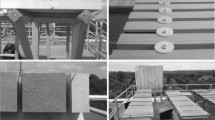Summary
A mathematical model for the simulation of mould fungi growth on wooden material is presented, based on previous regression models for mould growth on sapwood of pine and spruce. Quantification of mould growth in the model is based on the mould index used in the experiments for visual inspection. The model consists of differential equations describing the growth rate of the mould index in different fluctuating conditions including the effect of exposure time, temperature, relative humidity and dry periods. Temperature and humidity conditions favourable for mould growth are presented as a mathematical model. The mould index has an upper limit which depends on temperature and relative humidity. This limiting value can also be interpreted as the critical relative humidity needed for mould growth depending also on the mould growth itself. The model enables to calculate the development of mould growth on the surface of small wooden samples exposed to arbitrary fluctuating temperature and humidity conditions including dry periods. The numerical values of the parameters included in the model are fitted for pine and spruce sapwood, but the functional form of the model can be reasoned to be valid also for other wood-based materials.
Similar content being viewed by others
Author information
Authors and Affiliations
Additional information
Received 18 May 1997
Rights and permissions
About this article
Cite this article
Hukka, A., Viitanen, H. A mathematical model of mould growth on wooden material. Wood Science and Technology 33, 475–485 (1999). https://doi.org/10.1007/s002260050131
Issue Date:
DOI: https://doi.org/10.1007/s002260050131




